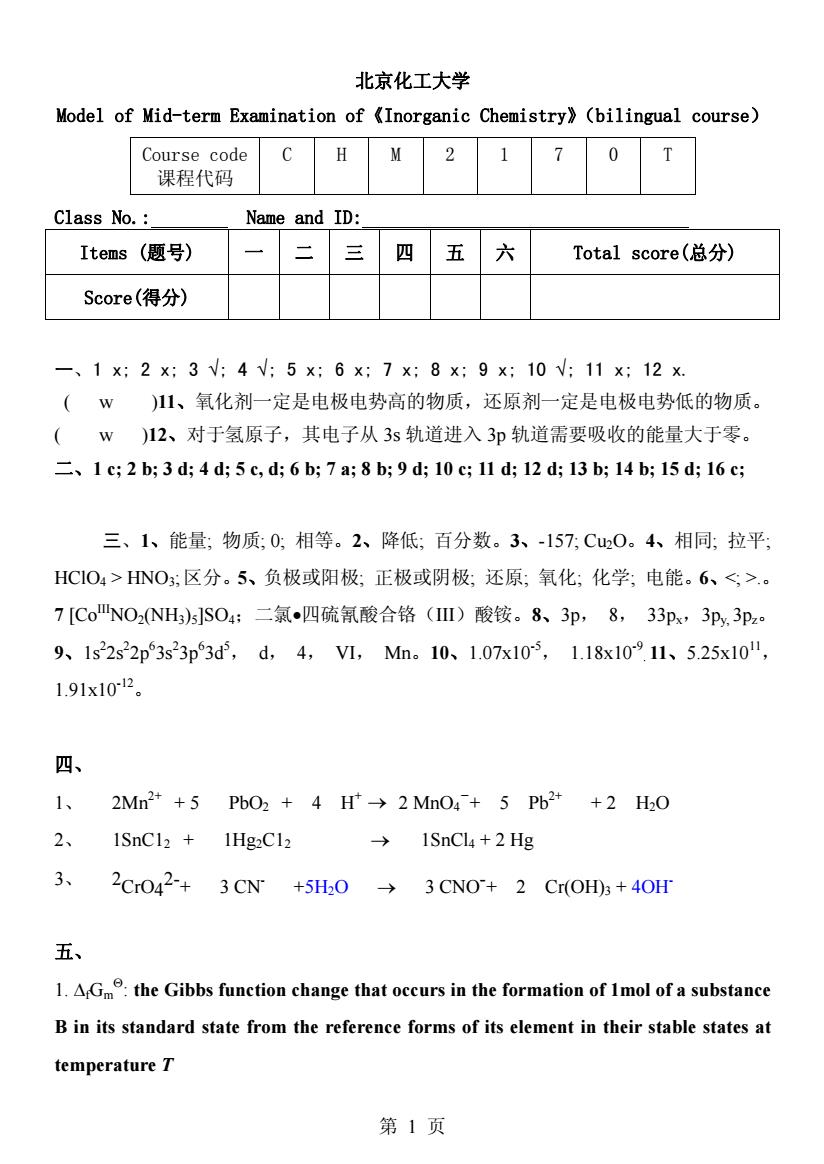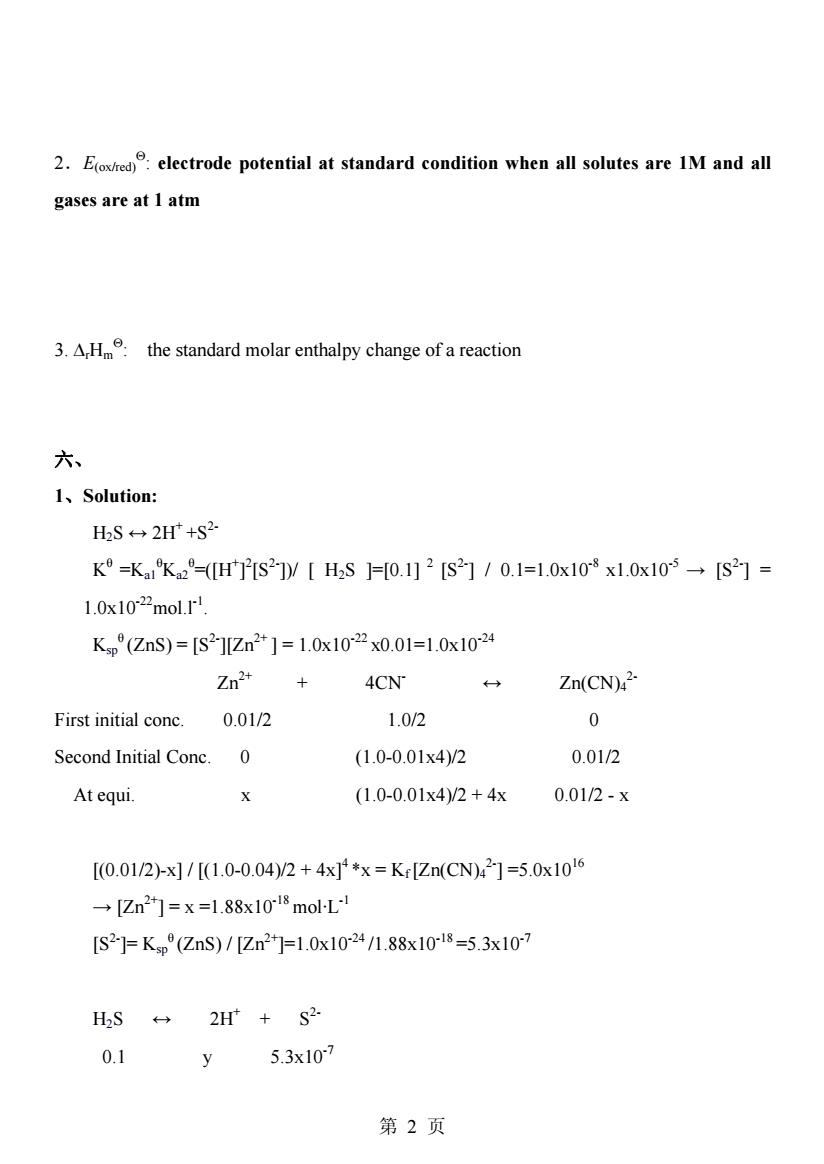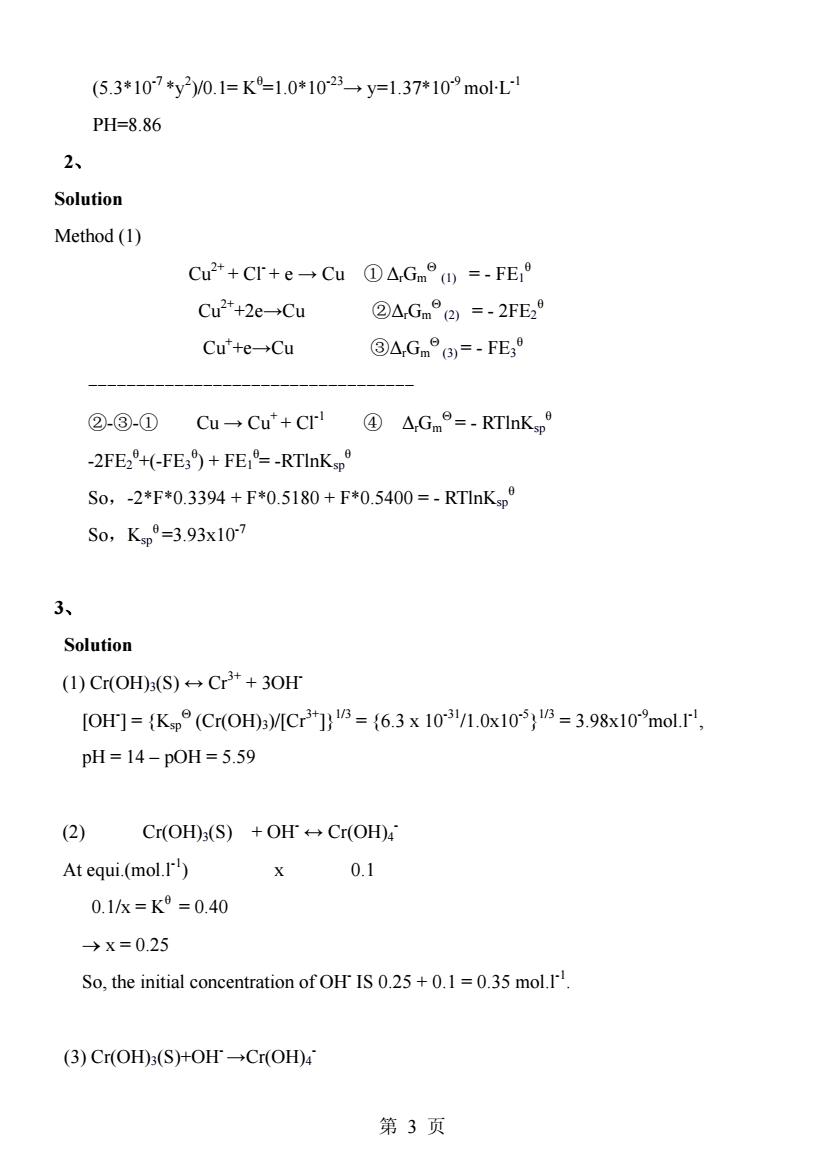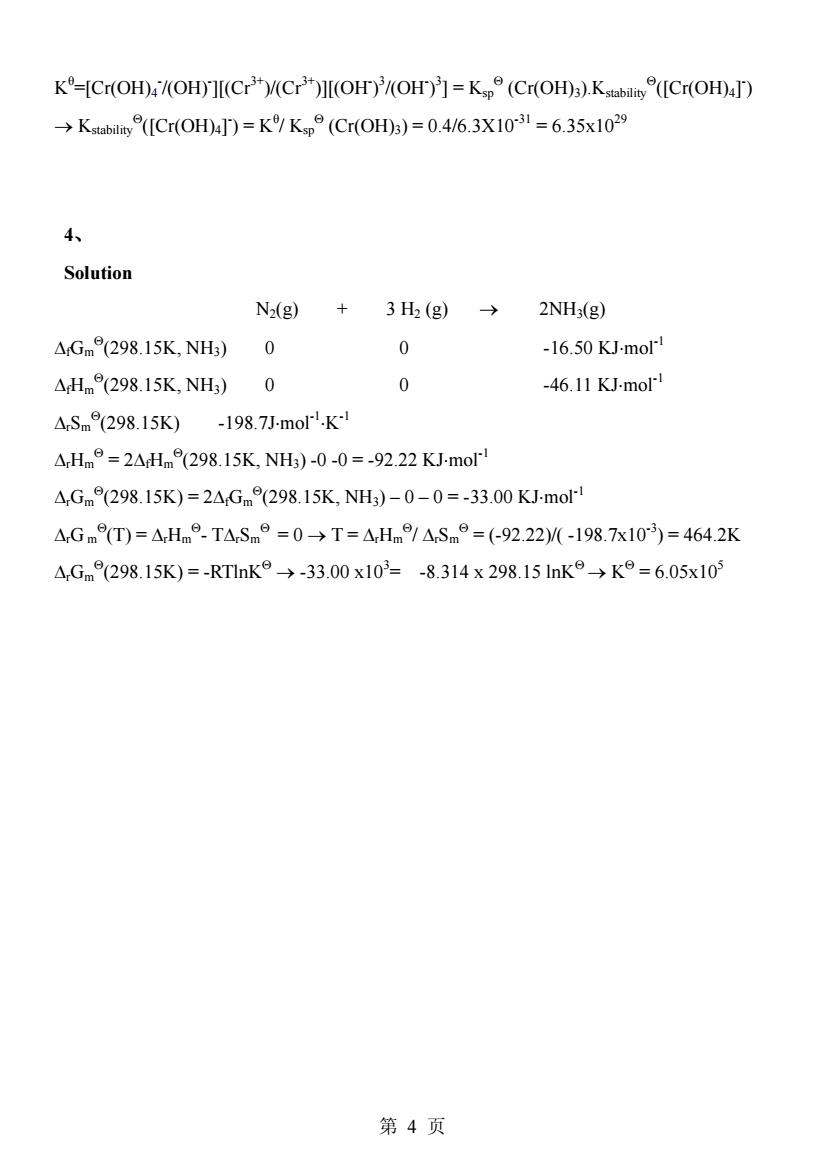
北京化工大学 Model of Mid-term Examination of (Inorganic Chemistry>(bilingual course) Course code C HM 2 170T 课程代码 Class No.: Name and ID: Items(题号) 三 四 五 六 Total score(总分) Score(得分) -、1x:2x:3:4:5x:6x:7x;8x;9x;10V:11x:12x ( w)11、氧化剂一定是电极电势高的物质,还原剂一定是电极电势低的物质。 (w)12、对于氢原子,其电子从3s轨道进入3印轨道需要吸收的能量大于零。 二、1c;2b;3d;4d;5c,d;6b;7a;8b;9d;10c;11d;12d;13b;14b;15d;16c 三、1、能量;物质:0;相等。2、降低;百分数。3、-157,Cu20.4、相同:拉平 HCIO4>HNO:区分。5、负极或阳极;正极或阴极;还原;氧化;化学;电能。6、<>.。 7[CoNO2(NH)5]SO4:二氯四硫氰酸合铬()酸铵。8、3p,8,33px,3p,3pz 9、1s22s22p3s23p3d,d,4,V1,Mm。10、1.07x103,1.18x109.11、5.25x10 1.91x102。 心 1、 2Mn2++5Pb02+4H→2MmO04+5Pb2++2H0 2、 1SnC12 1Hg2C12 →1SnCl4+2Hg 3 2Cr042-+3CN +5H2O 3CNO+2 Cr(OH)+40H 五、 1.AGm:the Gibbs function change that occurs in the formation of Imol of a substance B in its standard state from the reference forms of its element in their stable states at temperature T 第1页
北京化工大学 Model of Mid-term Examination of《Inorganic Chemistry》(bilingual course) Course code 课程代码 C H M 2 1 7 0 T Class No.: Name and ID: Items (题号) 一 二 三 四 五 六 Total score(总分) Score(得分) 一、1 x; 2 x; 3 √; 4 √; 5 x; 6 x; 7 x; 8 x; 9 x; 10 √; 11 x; 12 x. ( w )11、氧化剂一定是电极电势高的物质,还原剂一定是电极电势低的物质。 ( w )12、对于氢原子,其电子从 3s 轨道进入 3p 轨道需要吸收的能量大于零。 二、1 c; 2 b; 3 d; 4 d; 5 c, d; 6 b; 7 a; 8 b; 9 d; 10 c; 11 d; 12 d; 13 b; 14 b; 15 d; 16 c; 三、1、能量; 物质; 0; 相等。2、降低; 百分数。3、-157; Cu2O。4、相同; 拉平; HClO4 > HNO3; 区分。5、负极或阳极; 正极或阴极; 还原; 氧化; 化学; 电能。6、.。 7 [CoIIINO2(NH3)5]SO4;二氯•四硫氰酸合铬(III)酸铵。8、3p, 8, 33px,3py, 3pz。 9、1s2 2s2 2p6 3s2 3p6 3d5 , d, 4, VI, Mn。10、1.07x10-5, 1.18x10-9 . 11、5.25x1011, 1.91x10-12。 四、 1、 2Mn2+ + 5 PbO2 + 4 H+ → 2 MnO4 -+ 5 Pb2+ + 2 H2O 2、 1SnC12 + 1Hg2C12 → 1SnCl4 + 2 Hg 3、 2CrO4 2-+ 3 CN- +5H2O → 3 CNO- + 2 Cr(OH)3 + 4OH- 五、 1. ΔfGm Θ: the Gibbs function change that occurs in the formation of 1mol of a substance B in its standard state from the reference forms of its element in their stable states at temperature T 第 1 页

2.E(xred):electrode potential at standard condition when all solutes are IM and all gases are at I atm 3.A,H the standard molar enthalpy change of a reaction 六、 1、Solution: H2S+2H*+S2 K=KK-(HIs2Y[HSF[0.12[S210.1=1.0x10x1.0x103→[S2= 1.0x1022mol. Kp9(ZnS)=S2]Zn2+]=1.0x102x0.01=1.0x1024 Zn2 4CN ← Zn(CN)42- First initial conc.0.01/2 1.0/2 0 Second Initial Conc.0 (1.0-0.01x4)/2 0.01/2 Atequi. (1.0-0.01x4)/2+4x 0.01/2-x [0.01/2)x/[(1.0-0.04)/2+4x*x=KrZn(CN)42=5.0x1016 →[Zn2=x=1.88x1018moL [S2-]=Km°(ZnS)/[Zn2=1.0x1024/1.88x1018=5.3x107 H2S+2H+S2 0.1 y 5.3x107 第2页
2.E(ox/red) Θ: electrode potential at standard condition when all solutes are 1M and all gases are at 1 atm 3. ΔrHm Θ: the standard molar enthalpy change of a reaction 六、 1、Solution: H2S ↔ 2H+ +S2- Kθ =Ka1 θ Ka2 θ =([H+ ] 2 [S2-])/ [ H2S ]=[0.1] 2 [S2-] / 0.1=1.0x10-8 x1.0x10-5 → [S2-] = 1.0x10-22mol.l-1. Ksp θ (ZnS) = [S2-][Zn2+ ] = 1.0x10-22 x0.01=1.0x10-24 Zn2+ + 4CN- ↔ Zn(CN)4 2- First initial conc. 0.01/2 1.0/2 0 Second Initial Conc. 0 (1.0-0.01x4)/2 0.01/2 At equi. x (1.0-0.01x4)/2 + 4x 0.01/2 - x [(0.01/2)-x] / [(1.0-0.04)/2 + 4x]4 *x = Kf [Zn(CN)4 2-] =5.0x1016 → [Zn2+] = x =1.88x10-18 mol·L-1 [S2-]= Ksp θ (ZnS) / [Zn2+]=1.0x10-24 /1.88x10-18 =5.3x10-7 H2S ↔ 2H+ + S2- 0.1 y 5.3x10-7 第 2 页

(5.3*107*y2)/0.1=K-1.0*1023→y=1.37*109moL PH=8.86 2、 Solution Method(1) Cu2+CIr+e→Cu①△,GmPw=-FE1° Cu+2e-Cu ②△,Gn°a=-2FE2 Cut+e→Cu ③△Gm96)=.FE3 ②-③-①Cu→Cu+CIr④△,Gme=.RTlnK0 -2FE20+(-FE3)+FE1=-RTlnKsp So,-2*F*0.3394+F*0.5180+F*0.5400=.RT1nKm9 So,Kp9=3.93x107 3、 Solution (1)Cr(OH):(S)+Cr+30H [OH]={Kp°(Cr(OH3)/[C3]}B={6.3x1031.0x10B=3.98x10%mol., pH=14-p0H=5.59 (2) Cr(OH)3(S)+OH+Cr(OH)4 At equi.(mol.) 0.1 0.1k=K=0.40 →x=0.25 So,the initial concentration of OH IS 0.25+0.1=0.35 mol. (3)Cr(OH)3(S)+OH-Cr(OH)4 第3页
(5.3*10-7 *y2 )/0.1= Kθ =1.0*10-23→ y=1.37*10-9 mol·L-1 PH=8.86 2、 Solution Method (1) Cu2+ + Cl- + e → Cu ① ΔrGm Θ (1) = - FE1 θ Cu2++2e→Cu ②ΔrGm Θ (2) = - 2FE2 θ Cu+ +e→Cu ③ΔrGm Θ (3) = - FE3 θ ---------------------------------- ②-③-① Cu → Cu+ + Cl-1 ④ ΔrGm Θ = - RTlnKsp θ -2FE2 θ +(-FE3 θ ) + FE1 θ = -RTlnKsp θ So,-2*F*0.3394 + F*0.5180 + F*0.5400 = - RTlnKsp θ So,Ksp θ =3.93x10-7 3、 Solution (1) Cr(OH)3(S) ↔ Cr3+ + 3OH- [OH- ] = {Ksp Θ (Cr(OH)3)/[Cr3+]}1/3 = {6.3 x 10-31/1.0x10-5}1/3 = 3.98x10-9mol.l-1, pH = 14 – pOH = 5.59 (2) Cr(OH)3(S) + OH- ↔ Cr(OH)4 - At equi.(mol.l-1) x 0.1 0.1/x = Kθ = 0.40 → x = 0.25 So, the initial concentration of OH- IS 0.25 + 0.1 = 0.35 mol.l-1. (3) Cr(OH)3(S)+OH- →Cr(OH)4 - 第 3 页

K=Cr(OH)(OH)]I(Cr(Cr)]I(OH)OH)]=Kp(Cr(OH)3).Kstabali([Cr(OH)4T) →Kstability9([Cr(OH4J)=K/Kp9(Cr(OH)3)=0.4/6.3X1031=6.35x1029 4、 Solution N2(g)+3H2(g)→2NH3(g) △Gm(298.15K,NH)0 0 -16.50KJmo △HmP(298.15K,NH)0 0 -46.11 KJ-mol △rSm9(298.15K) -198.7J-molK1 △Hm9=2△Hm°(298.15KNH)-0-0=-92.22KJ-mol △,Gm9(298.15K)=2△,Gm9(298.15K,NH)-0-0=-33.00 KJ-mol" △,Gm9(T)=AHm9.TArSm9=0-→T=△Hme1△Sm9=(92.22)/-198.7x103=464.2K △,Gm(298.15K)=-RTlnK°→-33.00x103=-8.314x298.151nK9→K°=6.05x10 第4页
Kθ =[Cr(OH)4 - /(OH)- ][(Cr3+)/(Cr3+)][(OH- ) 3 /(OH- ) 3 ] = Ksp Θ (Cr(OH)3).Kstability Θ([Cr(OH)4] - ) → Kstability Θ([Cr(OH)4] - ) = Kθ / Ksp Θ (Cr(OH)3) = 0.4/6.3X10-31 = 6.35x1029 4、 Solution N2(g) + 3 H2 (g) → 2NH3(g) ΔfGm Θ(298.15K, NH3) 0 0 -16.50 KJ⋅mol-1 ΔfHm Θ(298.15K, NH3) 0 0 -46.11 KJ⋅mol-1 ΔrSm Θ(298.15K) -198.7J⋅mol-1⋅K-1 ΔrHm Θ = 2ΔfHm Θ(298.15K, NH3) -0 -0 = -92.22 KJ⋅mol-1 ΔrGm Θ(298.15K) = 2ΔfGm Θ(298.15K, NH3) – 0 – 0 = -33.00 KJ⋅mol-1 ΔrG mΘ(T) = ΔrHm Θ- TΔrSm Θ = 0 → T = ΔrHm Θ/ ΔrSm Θ = (-92.22)/( -198.7x10-3) = 464.2K ΔrGm Θ(298.15K) = -RTlnKΘ → -33.00 x103 = -8.314 x 298.15 lnKΘ → KΘ = 6.05x105 第 4 页